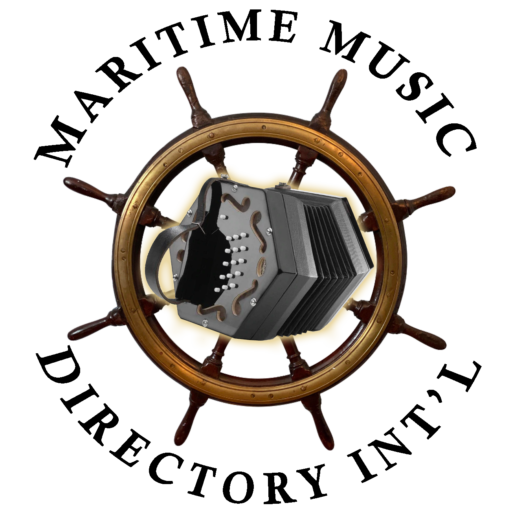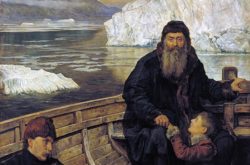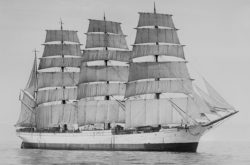Henry Hudson Set Adrift
Henry Hudson Set Adrift by mutineers (June 22, 1611)
After spending a winter trapped by ice in present-day Hudson Bay, the starving crew of the Discovery mutinies against its captain, English navigator Henry Hudson, and sets him, his teenage son, and . . .
Henry Hudson Set Adrift by Mutineers (1611)
After spending a winter trapped by ice in present-day Hudson Bay, the starving crew of the Discovery mutinies against its captain, English navigator Henry Hudson, and sets . . .
Henry Hudson Set Adrift by mutineers (1611)
After spending a winter trapped by ice in present-day Hudson Bay, the starving crew of the Discovery mutinies against its captain, English navigator Henry Hudson, and . . .
Herman Melville sails for the South Seas (1841)
On January 3, 1841, Herman Melville ships out on the whaler Acushnet to the South Seas.
Melville was born in New York City in 1819. A childhood bout of scarlet fever permanently . . .
Herman Melville sails for the South Seas (3 Jan 1841)
On January 3, 1841, Herman Melville ships out on the whaler Acushnet to the South Seas.
Melville was born in New York City in 1819. A childhood bout of scarlet fever permanently . . .
Herzogin Cecile grounds on Ham Stone Rock (1935)
With Sven Erikson as her captain and Elis Karlsson her first mate, the ship left Port Lincoln in South Australia on 21 January 1935, with a cargo of wheat, and after taking . . .
Hollywood and the Sea:
Maritime History & Culture in Film
Register Here for the Zoom Seminar
Saturday, 5 November 2022
Welcome & Lecture at 11:00 AM ET, Q&A to Follow
Seminars are free to attend, although we hope you will . . .
Horatio Nelson’s Birthday (29 Sept 1758)
Born on 29 September 1758 in Burnham Thorpe, Norfolk, Horatio Nelson was the sixth of the 11 children of a clergyman. He joined the navy aged 12, on a ship commanded by a maternal uncle. He became a . . .
Hundreds drown in Eastland disaster (24 July 1915)
On July 24, 1915, the steamer Eastland overturns in the Chicago River, drowning between 800 and 850 of its passengers who were heading to a picnic. The disaster was caused . . .
Interesting NPR show on sea shanties, pirates, lighthouses, white whales and more
This is an interesting listen for maritime music and sea shanty fans. Interviewer Davis Dunavin features some prominent names from the contemporary music scene, along with . . .
Inventor of the Naval Chronometer Born (1693)
Born today 1693, John Harrison, the cantankerous Yorkshireman who would go on to invent the naval chronometer and solve the mystery of calculating longitude at sea.
Read . . .
Inventor of the Naval Chronometer Born (1693)
Born today, April 3, 1693, John Harrison, the cantankerous Yorkshireman who would go on to invent the naval chronometer and solve the mystery of calculating longitude at sea.
Read . . .
Jack Forbes Dies (2016)
Jack Forbes was a member of the Hoy Shanty Crew and Slow Loris. Jack passed away on January 30, 2016. He was the author of the much-covered modern maritime song, Rolling . . .
John Paul Jones burns Whitehaven, England
At 8 a.m. on April 23, 1778, John Paul Jones, with 30 volunteers from his ship, the USS Ranger, launches a surprise attack on the two harbor forts at Whitehaven, England. . . .
John Paul Jones burns Whitehaven, England (1778)
At 8 a.m. on April 23, 1778, John Paul Jones, with 30 volunteers from his ship, the USS Ranger, launches a surprise attack on the two harbor forts at Whitehaven, . . .
John Paul Jones dies
Naval hero John Paul Jones dies in Paris
On July 18, 1792, the Revolutionary War naval hero John Paul Jones dies in his Paris apartment, where he was still awaiting a commission as the United States consul to Algiers. Commander Jones, remembered as one of the most daring and successful naval commanders of the American Revolution, was born in Scotland, on July 6, 1747. He became an apprentice to a merchant at 13 and soon went to sea, traveling first to the West Indies and then to North America as a young man.
In Virginia at the onset of the American Revolution, Jones sided with the Patriots and received a commission as a first lieutenant in the Continental Navy on December 7, 1775. After departing from Brest, Jones successfully executed raids on two forts in England’s Whitehaven Harbor, despite a disgruntled crew more interested in gain than honor. Jones then continued to his home territory of Kirkcudbright Bay, Scotland, where he intended to abduct the earl of Selkirk and then exchange him for American sailors held captive by Britain. Although he did not find the earl at home, Jones’ crew was able to steal all his silver, including his wife’s teapot, still containing her breakfast tea. From Scotland, Jones sailed across the Irish Sea to Carrickfergus, where his Ranger captured the HMS Drake after delivering fatal wounds to the British ship’s captain and lieutenant.
John Paul Jones Sails to Raid British Ships (1777)
On November 2, 1777, the USS Ranger, with a crew of 140 men under the command of John Paul Jones, leaves Portsmouth, New Hampshire, for the naval port at Brest, France, where it will stop before heading . . .
John Paul Jones Sets Out (1778)
Revolutionary War commander John Paul Jones sets out to raid British ships
On April 10, 1778, Commander John Paul Jones and his crew of 140 men aboard the USS Ranger set . . .
John Paul Jones Sets Sail
On November 2, 1777, the USS Ranger, with a crew of 140 men under the command of John . . .
John Paul Jones wins in English waters (23 Sept 1779)
During the American Revolution, . . .















